An Objective Injury Threshold for the Maximum Principal Strain Criterion for Brain Tissue in the Finite Element Head Model and Its Application
Abstract
1. Introduction
2. Methods
2.1. Establishment of a Large Simulation Dataset
2.2. Determination of an Objective Injury Threshold for MPS Criterion
2.3. Clinical Case and Corresponding Occipital Impact
2.4. Occipital Impacts for Application
3. Results
3.1. The Objective Injury Threshold
3.2. Injured Areas in FEHM and CT Images
3.3. Injured Predictions in Occipital Impacts
4. Discussion
4.1. Objectivity Analysis for the New Threshold
4.2. Rationality of the New MPS Injury Threshold
4.3. Visual Memory Impairment and Supra-Tentorium Cerebelli Injury
5. Conclusions
Author Contributions
Funding
Institutional Review Board Statement
Informed Consent Statement
Data Availability Statement
Acknowledgments
Conflicts of Interest
Appendix A

| Part | LS-DYNA Material Model | Material Properties |
|---|---|---|
| Brain | Kelvin–Maxwell viscoelastic | |
| Skull | Elastic | |
| CSF/ventricles | Viscoelastic | |
| Pia mater/Arachnoid | Elastic | |
| Dura mater | Elastic | |
| Falx/tentorium | Elastic | |
| Concrete | Elastic | |
| Football (size 5) (a diameter of 220 mm and an internal pressure of 0.9 bar) | Ogden rubber (Outer panel) (Thicknesses: 2.2 mm) | |
| Ogden rubber (bladder) (Thicknesses: 0.8 mm) |
Appendix B
| Scenario | Scenario | ||
|---|---|---|---|
| 1 | 0-90-90 (0) | 26 | 60-45-60 (0) |
| 2 | 15-90-75 (0) | 27 | 69-30-69 (0) |
| 3 | 30-90-60 (0) | 28 | 127-60-52 (0) |
| 4 | 45-90-45 (0) | 29 | 135-45-60 (0) |
| 5 | 60-90-30 (0) | 30 | 110-30-69 (0) |
| 6 | 75-90-15 (0) | 31 | 45-90-45 (1-1) |
| 7 | 90-90-0 (0) | 32 | 45-90-45 (1-2) |
| 8 | 105-90-15 (0) | 33 | 45-90-45 (1-3) |
| 9 | 120-90-30 (0) | 34 | 45-90-45 (1-4) |
| 10 | 135-90-45 (0) | 35 | 90-90-0 (1-1) |
| 11 | 150-90-60 (0) | 36 | 90-90-0 (1-2) |
| 12 | 165-90-75 (0) | 37 | 90-90-0 (1-3) |
| 13 | 180-90-90 (0) | 38 | 90-90-0 (1-4) |
| 14 | 90-0-90 (0) | 39 | 180-90-90 (1-1) |
| 15 | 105-15-90 (0) | 40 | 180-90-90 (1-2) |
| 16 | 120-30-90 (0) | 41 | 180-90-90 (1-3) |
| 17 | 135-45-90 (0) | 42 | 180-90-90 (1-4) |
| 18 | 150-60-90 (0) | 43 | 90-0-90 (1-1) |
| 19 | 165-75-90 (0) | 44 | 90-0-90 (1-2) |
| 20 | 90-75-15 (0) | 45 | 90-0-90 (1-3) |
| 21 | 90-60-30 (0) | 46 | 90-0-90 (1-4) |
| 22 | 90-45-45 (0) | 47 | 60-45-60 (1-1) |
| 23 | 90-30-60 (0) | 48 | 90-45-45 (1-1) |
| 24 | 90-15-75 (0) | 49 | 135-45-60 (1-1) |
| 25 | 52-60-52 (0) | 50 | 135-45-90 (1-1) |

Appendix C

References
- Ganpule, S.; Alai, A.; Plougonven, E.; Chandra, N. Mechanics of Blast Loading on the Head Models in the Study of Traumatic Brain Injury Using Experimental and Computational Approaches. Biomech. Model. Mechanobiol. 2013, 12, 511–531. [Google Scholar] [CrossRef] [PubMed]
- Post, A.; Hoshizaki, T.B.; Gilchrist, M.D.; Brien, S.; Cusimano, M.; Marshall, S. Traumatic Brain Injuries: The Influence of the Direction of Impact. Neurosurgery 2015, 76, 81–91. [Google Scholar] [CrossRef] [PubMed]
- Donat, C.K.; Lopez, M.Y.; Sastre, M.; Baxan, N.; Goldfinger, M.; Seeamber, R.; Müller, F.; Davies, P.; Hellyer, P.; Siegkas, P.; et al. From Biomechanics to Pathology: Predicting Axonal Injury from Patterns of Strain after Traumatic Brain Injury. Brain 2021, 144, 70–91. [Google Scholar] [CrossRef] [PubMed]
- Wilhelm, J.; Ptak, M.; Rusiński, E. Simulated Depiction of Head and Brain Injuries in the Context of Cellularbased Materials in Passive Safety Devices. Sci. J. Marit. Univ. Szczec. 2017, 122, 98–104. [Google Scholar] [CrossRef]
- Hassan, M.T.Z.; Meguid, S.A. Effect of Seat Belt and Head Restraint on Occupant’s Response during Rear-End Collision. Int. J. Mech. Mater. Des. 2018, 14, 231–242. [Google Scholar] [CrossRef]
- Tse, K.M.; Holder, D. A Biomechanical Evaluation of a Novel Airbag Bicycle Helmet Concept for Traumatic Brain Injury Mitigation. Bioengineering 2021, 8, 173. [Google Scholar] [CrossRef]
- Goldsmith, W. The State of Head Injury Biomechanics: Past, Present, and Future: Part 1. Crit. Rev. Biomed. Eng. 2001, 29, 441–600. [Google Scholar] [CrossRef]
- Ji, S.; Ghajari, M.; Mao, H.; Kraft, R.H.; Hajiaghamemar, M.; Panzer, M.B.; Willinger, R.; Gilchrist, M.D.; Kleiven, S.; Stitzel, J.D. Use of Brain Biomechanical Models for Monitoring Impact Exposure in Contact Sports. Ann. Biomed. Eng. 2022, 50, 1389–1408. [Google Scholar] [CrossRef]
- Kimpara, H.; Iwamoto, M. Mild Traumatic Brain Injury Predictors Based on Angular Accelerations during Impacts. Ann. Biomed. Eng. 2012, 40, 114–126. [Google Scholar] [CrossRef]
- Takhounts, E.G.; Craig, M.J.; Moorhouse, K.; McFadden, J.; Hasija, V. Development of Brain Injury Criteria (BrIC). Stapp Car Crash J. 2013, 57, 243–266. [Google Scholar]
- Post, A.; Kendall, M.; Cournoyer, J.; Taylor, K.; Hoshizaki, T.B.; Gilchrist, M.D.; Brien, S.; Cusimano, M.D.; Marshall, S. Falls Resulting in Mild Traumatic Brain Injury and Focal Traumatic Brain Injury: A Biomechanical Analysis. Int. J. Crashworthines 2018, 23, 278–289. [Google Scholar] [CrossRef]
- Laksari, K.; Fanton, M.; Wu, L.C.; Nguyen, T.H.; Kurt, M.; Giordano, C.; Kelly, E.; O’Keeffe, E.; Wallace, E.; Doherty, C.; et al. Multi-Directional Dynamic Model for Traumatic Brain Injury Detection. J. Neurotrauma 2020, 37, 982–993. [Google Scholar] [CrossRef]
- Ward, C.; Chan, M.; Nahum, A. Intracranial Pressure–A Brain Injury Criterion. SAE Trans. 1980, 89, 3867–3880. [Google Scholar] [CrossRef]
- Willinger, R.; Baumgartner, D. Human Head Tolerance Limits to Specific Injury Mechanisms. Int. J. Crashworthines 2003, 8, 605–617. [Google Scholar] [CrossRef]
- Zhang, L.; Yang, K.H.; King, A.I. A Proposed Injury Threshold for Mild Traumatic Brain Injury. J. Biomech. Eng. 2004, 126, 226–236. [Google Scholar] [CrossRef]
- Patton, D.A.; McIntosh, A.S.; Kleiven, S.; Fréchède, B. Injury Data from Unhelmeted Football Head Impacts Evaluated against Critical Strain Tolerance Curves. Proc. IMechE Part P J. Sports Eng. Technol. 2012, 226, 177–184. [Google Scholar] [CrossRef]
- Patton, D.A.; McIntosh, A.S.; Kleiven, S. The Biomechanical Determinants of Concussion: Finite Element Simulations to Investigate Brain Tissue Deformations during Sporting Impacts to the Unprotected Head. J. Appl. Biomech. 2013, 29, 721–730. [Google Scholar] [CrossRef] [PubMed]
- Wright, R.M.; Ramesh, K.T. An Axonal Strain Injury Criterion for Traumatic Brain Injury. Biomech. Model. Mechanobiol. 2012, 11, 245–260. [Google Scholar] [CrossRef]
- Giordano, C.; Kleiven, S. Evaluation of Axonal Strain as a Predictor for Mild Traumatic Brain Injuries Using Finite Element Modeling. Stapp Car Crash J. 2014, 58, 29–61. [Google Scholar] [CrossRef]
- Deck, C.; Willinger, R. Added Value of Tissue Level Brain Injury Criteria. Int. J. Automot. Eng. 2019, 10, 191–196. [Google Scholar] [CrossRef][Green Version]
- Willinger, R.; Deck, C.; Bourdet, N. Head Trauma Biomechanics; Tiwari, G., Mohan, D., Eds.; Springer: Singapore, 2021; ISBN 9789811611148. [Google Scholar]
- Zhan, X.; Oeur, A.; Liu, Y.; Zeineh, M.M.; Grant, G.A.; Margulies, S.S.; Camarillo, D.B. Translational Models of Mild Traumatic Brain Injury Tissue Biomechanics. Curr. Opin. Biomed. Eng. 2022, 24, 100422. [Google Scholar] [CrossRef]
- Ghajari, M.; Hellyer, P.J.; Sharp, D.J. Computational Modelling of Traumatic Brain Injury Predicts the Location of Chronic Traumatic Encephalopathy Pathology. Brain 2017, 140, 333–343. [Google Scholar] [CrossRef]
- Wan, Z.; Lan, H.; Lin, S.; Dai, H. Defect Detection and Repair Algorithm for Structures Generated by Topology Optimization Based on 3D Hierarchical Fully Convolutional Network. Biomim. Intell. Robot. 2024, 4, 100149. [Google Scholar] [CrossRef]
- Kleiven, S. Predictors for Traumatic Brain Injuries Evaluated through Accident Reconstructions. Stapp Car Crash J. 2007, 29, 81–114. [Google Scholar] [CrossRef]
- Clark, J.M.; Adanty, K.; Post, A.; Hoshizaki, T.B.; Clissold, J.; McGoldrick, A.; Hill, J.; Annaidh, A.N.; Gilchrist, M.D. Proposed Injury Thresholds for Concussion in Equestrian Sports. J. Sci. Med. Sport. 2020, 23, 222–236. [Google Scholar] [CrossRef] [PubMed]
- Viano, D.C.; Casson, I.R.; Pellman, E.J.; Zhang, L.; King, A.I.; Yang, K.H. Concussion in Professional Football: Brain Responses by Finite Element Analysis: Part 9. Neurosurgery 2005, 57, 891–916. [Google Scholar] [CrossRef] [PubMed]
- McAllister, T.W.; Ford, J.C.; Ji, S.; Beckwith, J.G.; Flashman, L.A.; Paulsen, K.; Greenwald, R.M. Maximum Principal Strain and Strain Rate Associated with Concussion Diagnosis Correlates with Changes in Corpus Callosum White Matter Indices. Ann. Biomed. Eng. 2012, 40, 127–140. [Google Scholar] [CrossRef]
- Ng, H.K.; Mahaliyana, R.D.; Poon, W.S. The Pathological Spectrum of Diffuse Axonal Injury in Blunt Head Trauma: Assessment with Axon and Myelin Stains. Clin. Neurol. Neurosurg. 1994, 96, 24–31. [Google Scholar] [CrossRef]
- Graham, N.S.N.; Jolly, A.; Zimmerman, K.; Bourke, N.J.; Scott, G.; Cole, J.H.; Schott, J.M.; Sharp, D.J. Diffuse Axonal Injury Predicts Neurodegeneration after Moderate–Severe Traumatic Brain Injury. Brain 2020, 143, 3685–3698. [Google Scholar] [CrossRef]
- Deck, C.; Willinger, R. Improved Head Injury Criteria Based on Head FE Model. Int. J. Crashworthines 2008, 13, 667–678. [Google Scholar] [CrossRef]
- Sahoo, D.; Deck, C.; Willinger, R. Brain Injury Tolerance Limit Based on Computation of Axonal Strain. Accid. Anal. Prev. 2016, 92, 53–70. [Google Scholar] [CrossRef]
- Yuan, Q.; Li, X.; Zhou, Z.; Kleiven, S. A Novel Framework for Video-Informed Reconstructions of Sports Accidents: A Case Study Correlating Brain Injury Pattern from Multimodal Neuroimaging with Finite Element Analysis. Brain Multiphys. 2024, 6, 100085. [Google Scholar] [CrossRef]
- Oshita, I. Recent Advances in THUMS: Development of Individual Internal Organs, Brain, Small Female, and Pedestrian Model. In Proceedings of the 4th European LS-DYNA Users Conference, Ulm, Germany, 22–23 May 2003. [Google Scholar]
- Tamura, A.; Nakahira, Y.; Iwamoto, M.; Watanabe, I.; Miki, K.; Hayashi, S.; Yasuki, T. The Influence of the Traction Force Due to Inertia of the Brain Mass on Traumatic Brain Injury during Suv-to-Pedestrian Impact. In Proceedings of the International IRCOBI Conference on the Biomechanics of Impact, IRCOBI, Madrid, Spain, 20–22 September 2006. [Google Scholar]
- Leijdesdorff, H.A.; Van Dijck, J.T.J.M.; Krijnen, P.; Vleggeert-Lankamp, C.L.A.M.; Schipper, I.B. Injury Pattern, Hospital Triage, and Mortality of 1250 Patients with Severe Traumatic Brain Injury Caused by Road Traffic Accidents. J. Neurotrauma 2014, 31, 459–465. [Google Scholar] [CrossRef] [PubMed]
- Li, F.; Li, H.; Xiao, Z.; Lu, R.; Zhang, Z.; Zhu, H.; Ren, L. A Review on Injury Mechanism of Intracerebral Hemorrhage in Vehicle Accidents. Curr. Pharm. Des. 2017, 23, 2177–2192. [Google Scholar] [CrossRef] [PubMed]
- Perkins, R.A.; Bakhtiarydavijani, A.; Ivanoff, A.E.; Jones, M.; Hammi, Y.; Prabhu, R.K. Assessment of Brain Injury Biomechanics in Soccer Heading Using Finite Element Analysis. Brain Multiphys. 2022, 3, 100052. [Google Scholar] [CrossRef]
- Cao, Y.; Liu, Y.; Tang, L.; Jiang, Z.; Liu, Z.; Zhou, L.; Yang, B. Quantitative Assessment of Brain Injury and Concussion Induced by an Unintentional Soccer Ball Impact. Injury 2024, 55, 111658. [Google Scholar] [CrossRef]
- Tiernan, S.; Byrne, G. The Effect of Impact Location on Brain Strain. Brain Injury 2019, 33, 427–434. [Google Scholar] [CrossRef]
- Baumgartner, D.; Willinger, R. Numerical Modeling of the Human Head under Impact: New Injury Mechanisms and Tolerance Limits. In IUTAM Symposium on Impact Biomechanics: From Fundamental Insights to Applications; Gilchrist, M.D., Ed.; Springer: Dordrecht, The Netherlands, 2005; pp. 195–203. [Google Scholar]
- Reddy, J.N. Energy Principles and Variational Methods in Applied Mechanics; Wiley: Hoboken, NJ, USA, 2017; ISBN 978-1-119-08737-3. [Google Scholar]
- Koo, T.K.; Guo, J.-Y.; Ippolito, C.; Bedle, J.C. Assessment of Scoliotic Deformity Using Spinous Processes: Comparison of Different Analysis Methods of an Ultrasonographic System. J. Manip. Physiol. Ther. 2014, 37, 667–677. [Google Scholar] [CrossRef]
- Ge, S.; Zeng, H.; Zheng, R. Automatic Measurement of Spinous Process Angles on Ultrasound Spine Images. In Proceedings of the 2020 42nd Annual International Conference of the IEEE Engineering in Medicine & Biology Society (EMBC), Montreal, QC, Canada, 20–24 July 2020; pp. 2101–2104. [Google Scholar]
- Alahmari, A. A Subdural Supratentorial Hemorrhage and Contusion after a Traumatic Brain Injury Mimicking a Dural Thickening: A Clinical Case. J. Radiol. Res. Diagn. Imaging 2022, 2. Available online: https://mediresonline.org/article/a-subdural-supratentorial-hemorrhage-and-contusion-after-a-traumatic-brain-injury-mimicking-a-dural-thickening-a-clinical-case (accessed on 21 June 2024). [CrossRef]
- Yang, Y.; Schonnop, R.; Feldman, F.; Robinovitch, S.N. Development and Validation of a Questionnaire for Analyzing Real-Life Falls in Long-Term Care Captured on Video. BMC Geriatr. 2013, 13, 40. [Google Scholar] [CrossRef]
- Meng, L.; Ceccarelli, M.; Yu, Z.; Chen, X.; Huang, Q. An Experimental Characterization of Human Falling Down. Mech. Sci. 2017, 8, 79–89. [Google Scholar] [CrossRef]
- Yu, X.; Baker, C.E.; Brown, M.; Ghajari, M. In-Depth Bicycle Collision Reconstruction: From a Crash Helmet to Brain Injury Evaluation. Bioengineering 2023, 10, 317. [Google Scholar] [CrossRef] [PubMed]
- Elabd, K. Biomechanical Analysis and Simulation of Backward Falls with Head Impact in Older Adults; University of Manitoba: Winnipeg, MB, Canada, 2017. [Google Scholar]
- Alahmari, A. Importance of the Oblique Reconstruction of CT Scan MPR Formatting: A Pictorial Review. Clin. Res. Neurol. 2021, 4, 1–4. [Google Scholar] [CrossRef]
- Jang, S.H.; Kwon, Y.H.; Lee, S.J. Abdominal Pain Due to the Spinothalamic Tract Injury in Patients with Mild Traumatic Brain Injury: A Case Report. BMC Neurol. 2020, 20, 117. [Google Scholar] [CrossRef]
- Jang, S.H.; Kwon, Y.H.; Lee, S.J. Contrecoup Injury of the Prefronto-Thalamic Tract in a Patient with Mild Traumatic Brain Injury: A Case Report. Medicine 2020, 99, e21601. [Google Scholar] [CrossRef]
- Kwon, H.G.; Jang, S.H. Delayed Gait Disturbance Due to Injury of the Corticoreticular Pathway in a Patient with Mild Traumatic Brain Injury. Brain Injury 2014, 28, 511–514. [Google Scholar] [CrossRef]
- Jang, S.H.; Kwon, Y.H.; Lee, S.J. Central Pain Due to Injury of the Spinothalamic Tract Misdiagnosed as Complex Regional Pain Syndrome: A Case Report. Diagnostics 2019, 9, 145. [Google Scholar] [CrossRef]
- Martin, C.B.; Barense, M.D. Perception and memory in the ventral visual stream and medial temporal lobe. Annu. Rev. Vis. Sci. 2023, 9, 409–434. [Google Scholar] [CrossRef]
- Squire, L.R.; Zola-Morgan, S. The Medial Temporal Lobe Memory System. Science 1991, 253, 1380–1386. [Google Scholar] [CrossRef]
- Silverberg, N.D.; Iaccarino, M.A.; Panenka, W.J.; Iverson, G.L.; McCulloch, K.L.; Dams-O’Connor, K.; Reed, N.; McCrea, M.; Cogan, A.M.; Park Graf, M.J.; et al. Management of Concussion and Mild Traumatic Brain Injury: A Synthesis of Practice Guidelines. Arch. Phys. Med. Rehabil. 2020, 101, 382–393. [Google Scholar] [CrossRef]
- Patton, D.A.; McIntosh, A.S.; Kleiven, S. The Biomechanical Determinants of Concussion: Finite Element Simulations to Investigate Tissue-Level Predictors of Injury during Sporting Impacts to the Unprotected Head. J. Appl. Biomech. 2015, 31, 264–268. [Google Scholar] [CrossRef] [PubMed]
- Wu, T.; Hajiaghamemar, M.; Giudice, J.S.; Alshareef, A.; Margulies, S.S.; Panzer, M.B. Evaluation of Tissue-Level Brain Injury Metrics Using Species-Specific Simulations. J. Neurotrauma 2021, 38, 1879–1888. [Google Scholar] [CrossRef] [PubMed]
- Young, H.A.; Schmidek, H.H. Complications Accompanying Occipital Skull Fracture. J. Trauma 1982, 22, 914–920. [Google Scholar] [CrossRef]
- Fahlstedt, M.; Depreitere, B.; Halldin, P.; Vander Sloten, J.; Kleiven, S. Correlation between Injury Pattern and Finite Element Analysis in Biomechanical Reconstructions of Traumatic Brain Injuries. J. Biomech. 2015, 48, 1331–1335. [Google Scholar] [CrossRef]
- Kang, W.H.; Morrison, B. Functional Tolerance to Mechanical Deformation Developed from Organotypic Hippocampal Slice Cultures. Biomech. Model. Mechanobiol. 2015, 14, 561–575. [Google Scholar] [CrossRef]
- Bain, A.C.; Meaney, D.F. Tissue-Level Thresholds for Axonal Damage in an Experimental Model of Central Nervous System White Matter Injury. J. Biomech. Eng. 2000, 122, 615–622. [Google Scholar] [CrossRef]
- Iranmanesh, P.; Ehsani, A.; Khademi, A.; Asefnejad, A.; Shahriari, S.; Soleimani, M.; Ghadiri Nejad, M.; Saber-Samandari, S.; Khandan, A. Application of 3D Bioprinters for Dental Pulp Regeneration and Tissue Engineering (Porous Architecture). Transp. Porous Med. 2022, 142, 265–293. [Google Scholar] [CrossRef]
- Hanna, M.; Ali, A.; Bhatambarekar, P.; Modi, K.; Lee, C.; Morrison, B.; Klienberger, M.; Pfister, B.J. Anatomical Features and Material Properties of Human Surrogate Head Models Affect Spatial and Temporal Brain Motion under Blunt Impact. Bioengineering 2024, 11, 650. [Google Scholar] [CrossRef]
- Jang, S.H.; Kwon, H.G. Aggravation of an Injured Dentato-Rubro-Thalamic Tract in a Patient with Mild Traumatic Brain Injury: A Case Report. Medicine 2017, 96, e8253. [Google Scholar] [CrossRef] [PubMed]
- Matsumoto, K.; Houri, T.; Yamaki, T.; Ueda, S. Traumatic Acute Subdural Hematoma Localized on the Superior Surface of the Tentorium Cerebelli. Neurol. Med. Chir. 1996, 36, 377–379. [Google Scholar] [CrossRef][Green Version]
- Takeuchi, S.; Takasato, Y.; Masaoka, H.; Hayakawa, T.; Hiroshi, Y.; Nagatani, K.; Otani, N.; Osada, H.; Wada, K.; Nawashiro, H. Traumatic Peritentorial Subdural Hematomas: A Study of 32 Cases. Turk. Neurosurg. 2011, 22, 305–308. [Google Scholar] [CrossRef][Green Version]
- Ak, H.; Çakir, Y.; Burgucu, O. Acute Traumatic Tentorial Subdural Hematoma: A Diagnostic Challenge. J. Clin. Med. Images Case Rep. 2023, 3, 1546. [Google Scholar] [CrossRef] [PubMed]
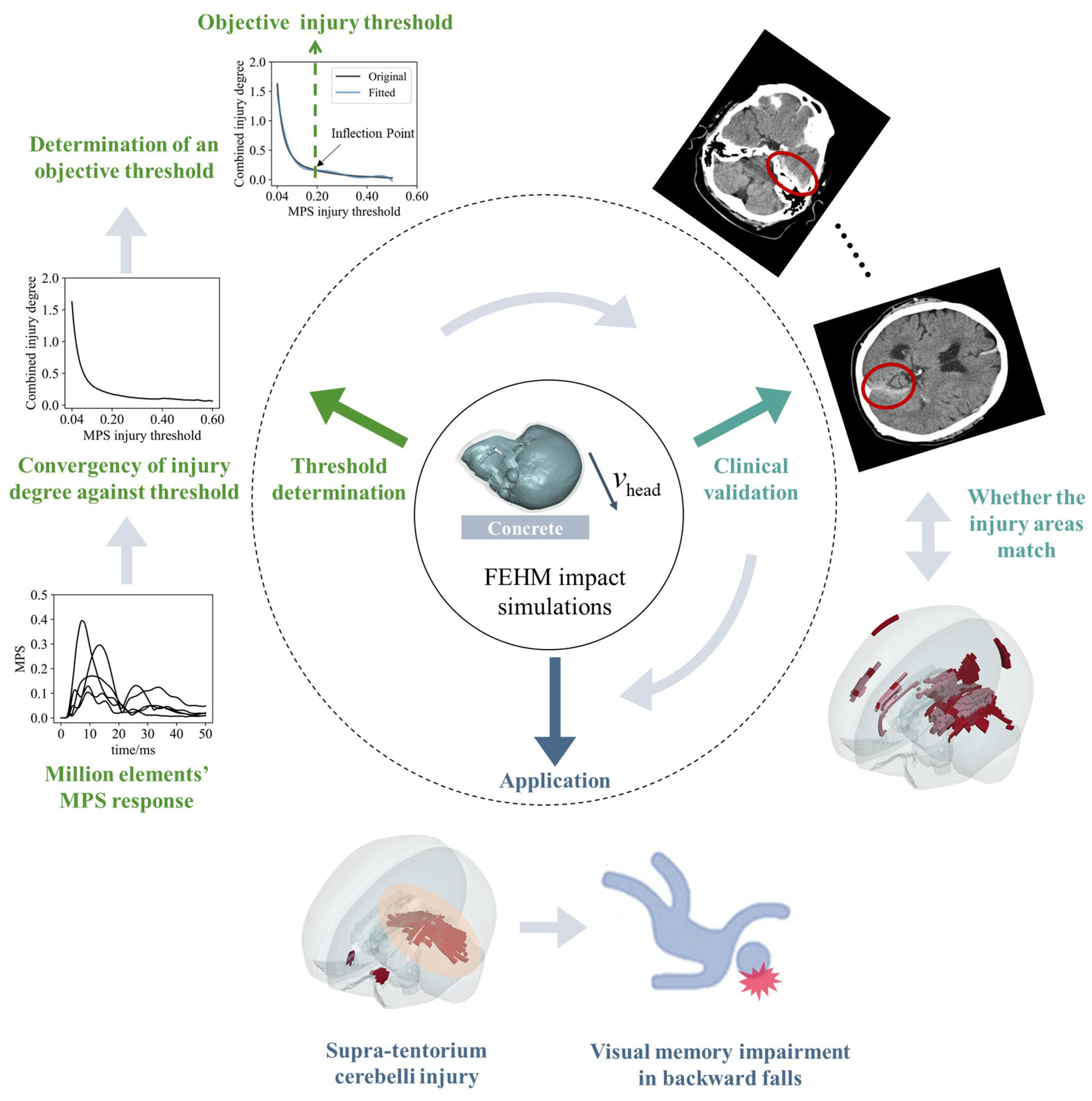
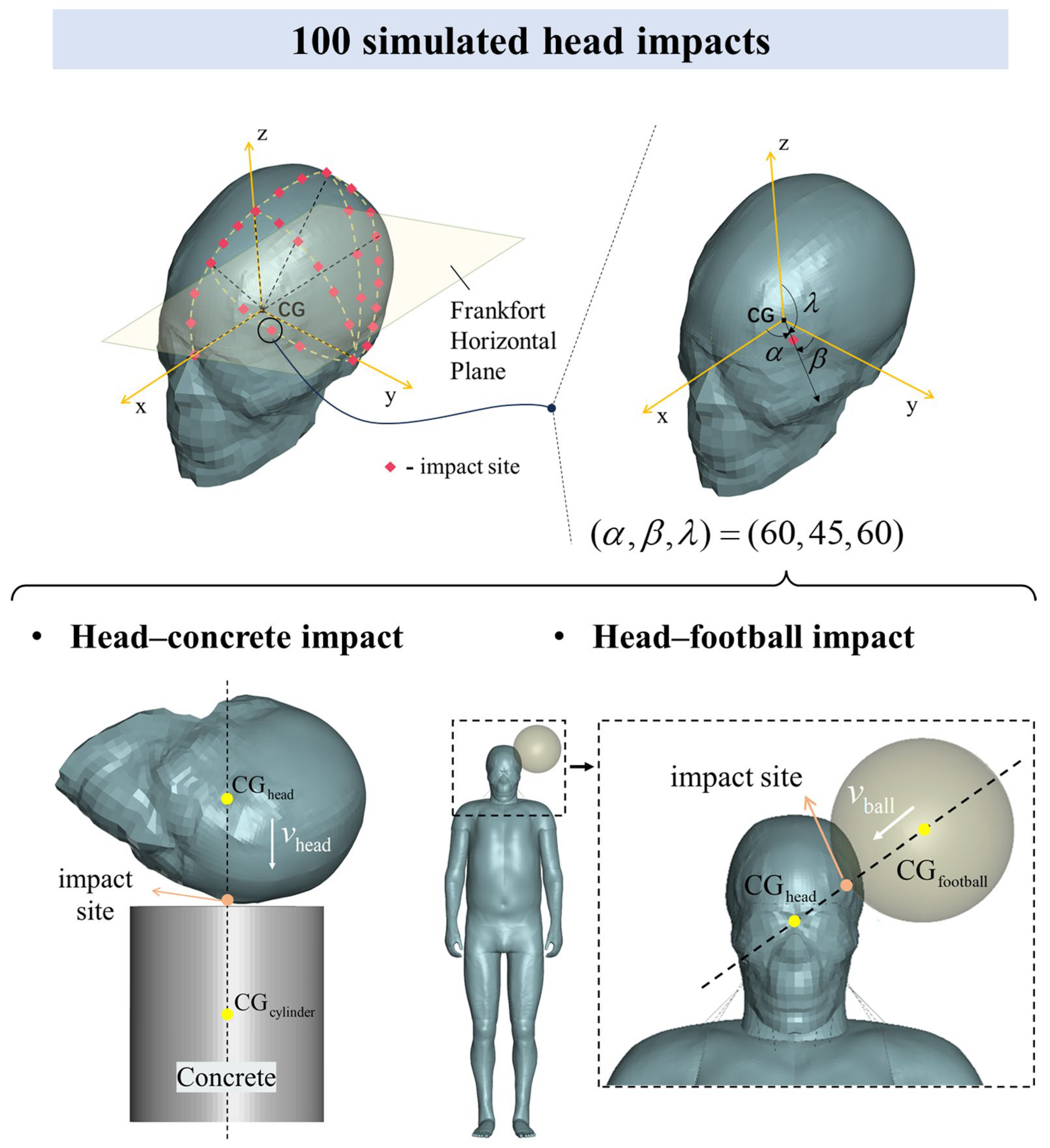
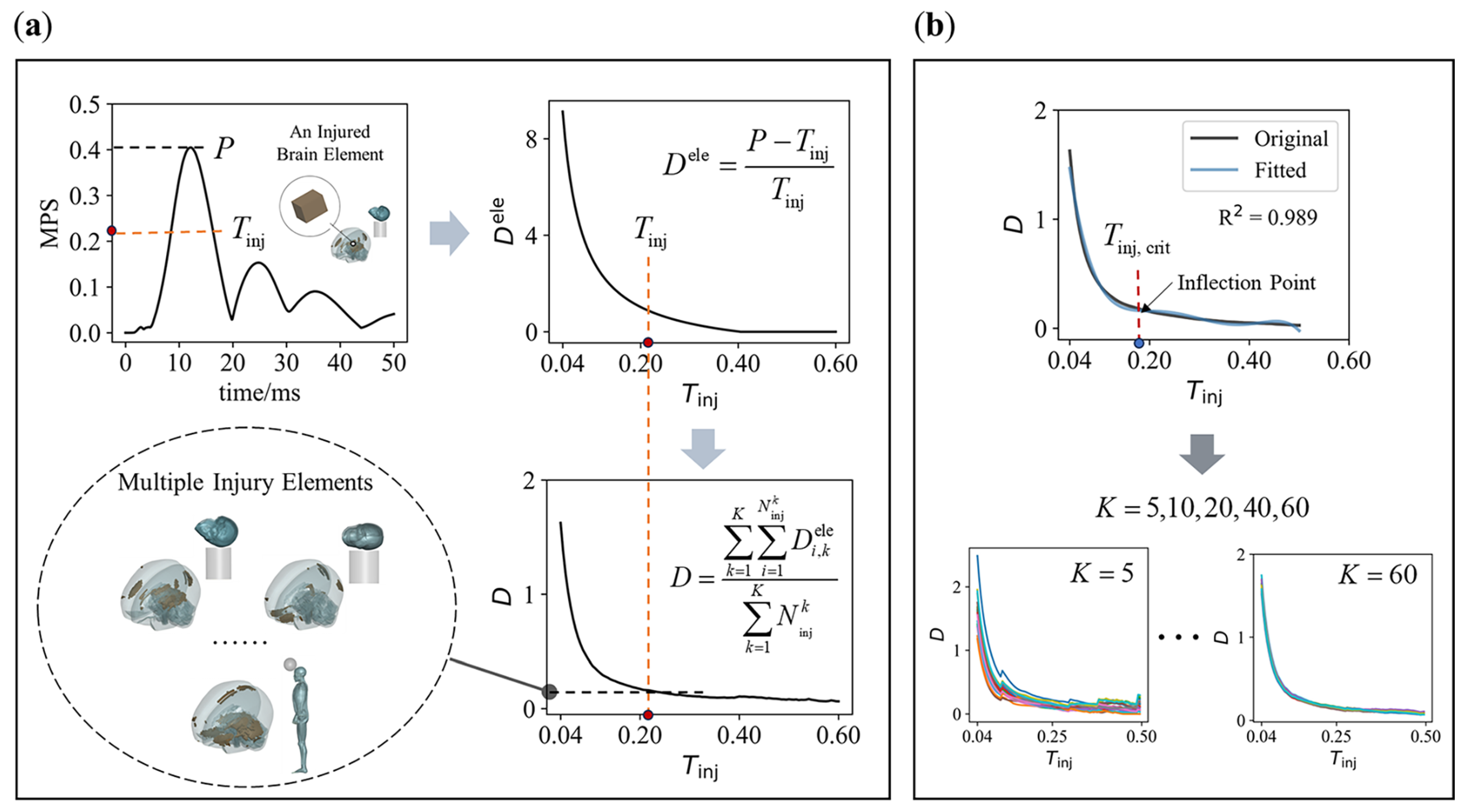
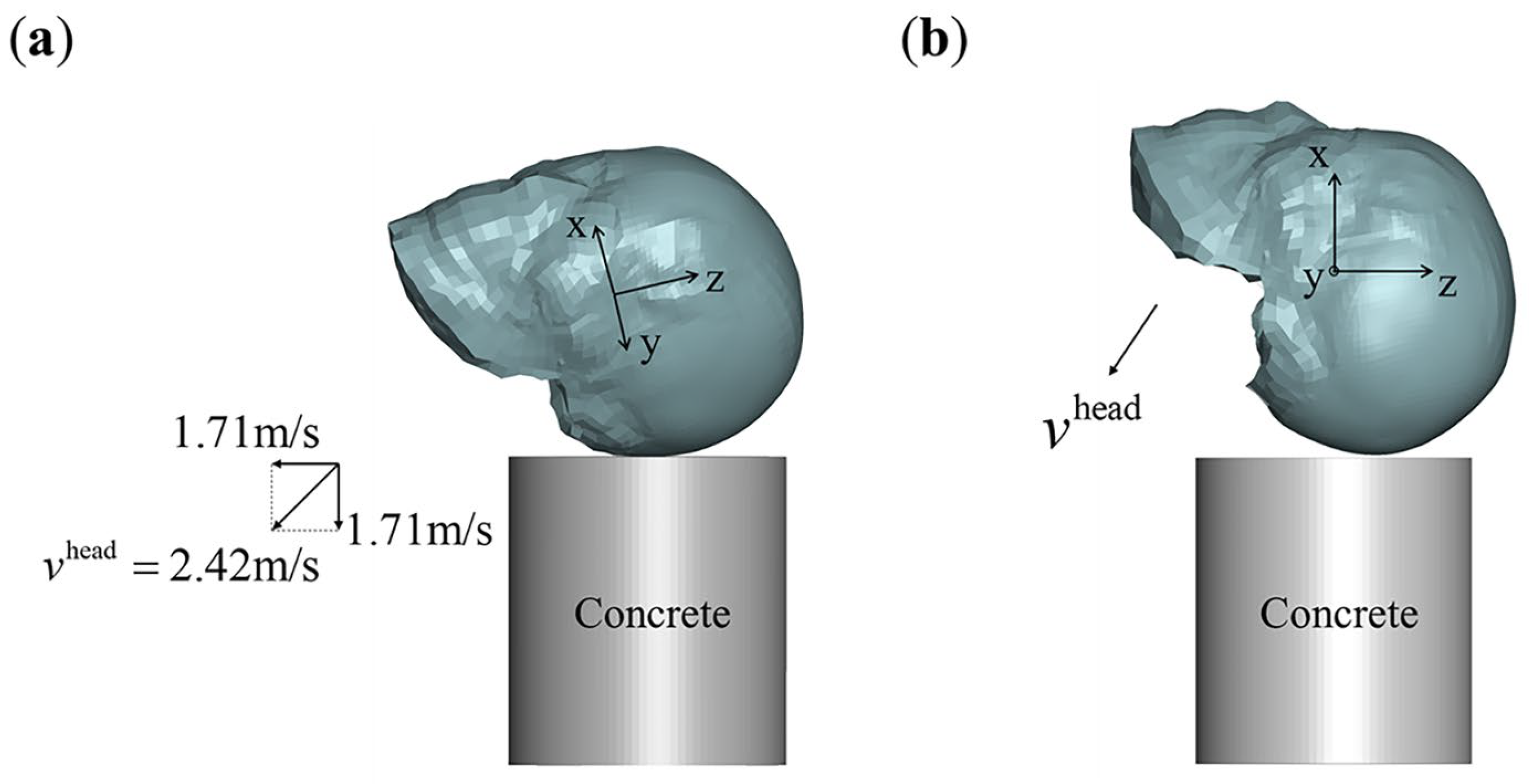
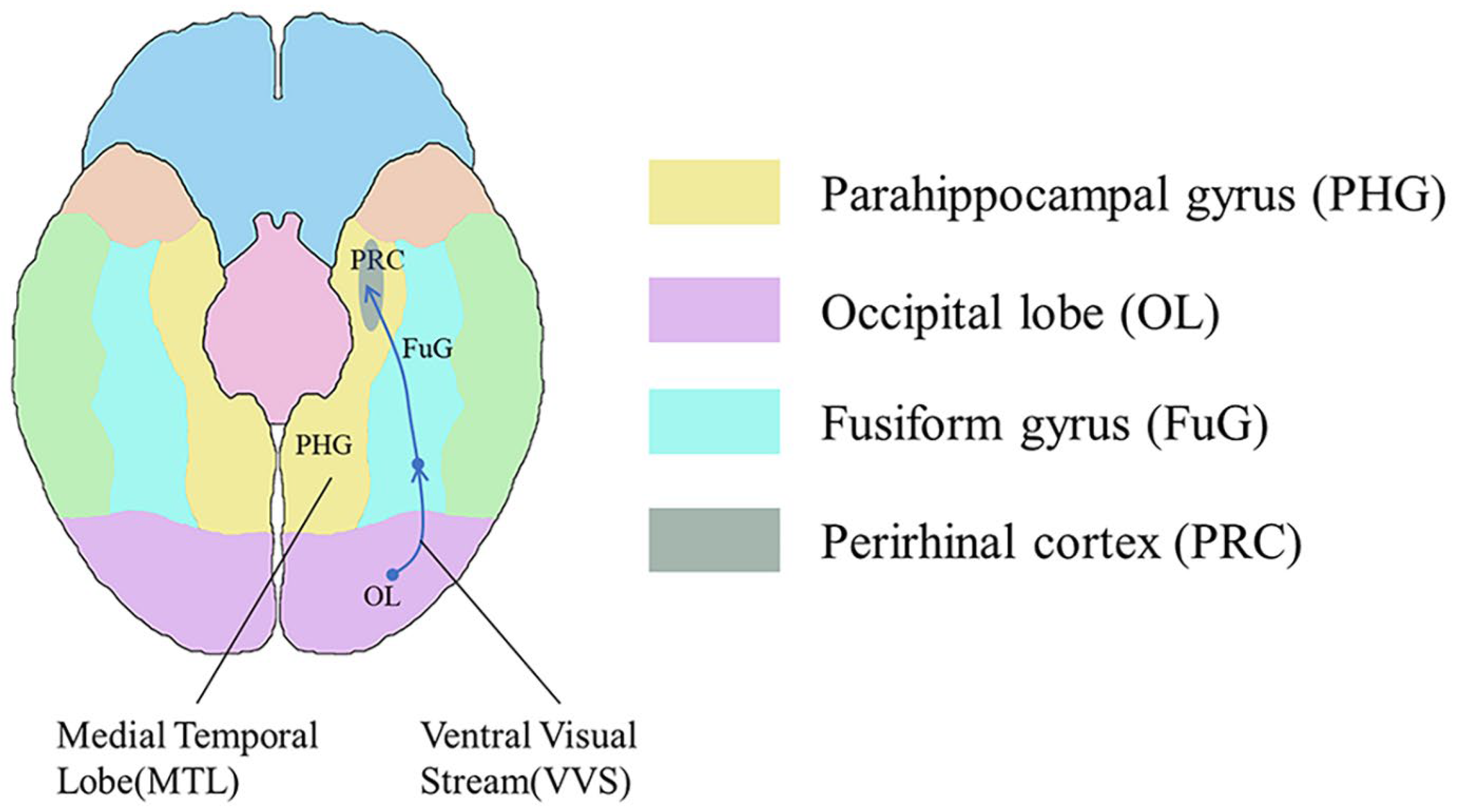

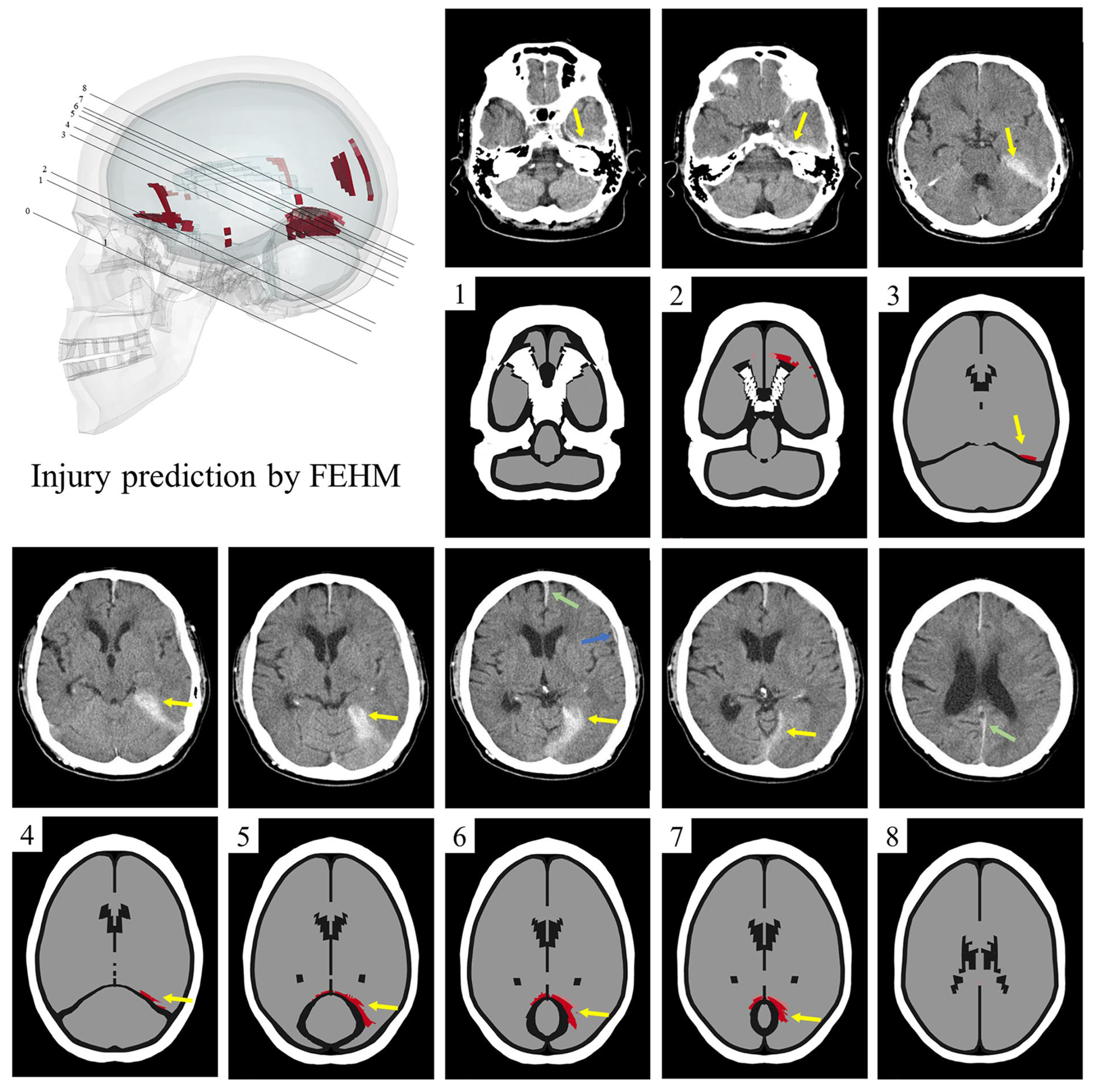

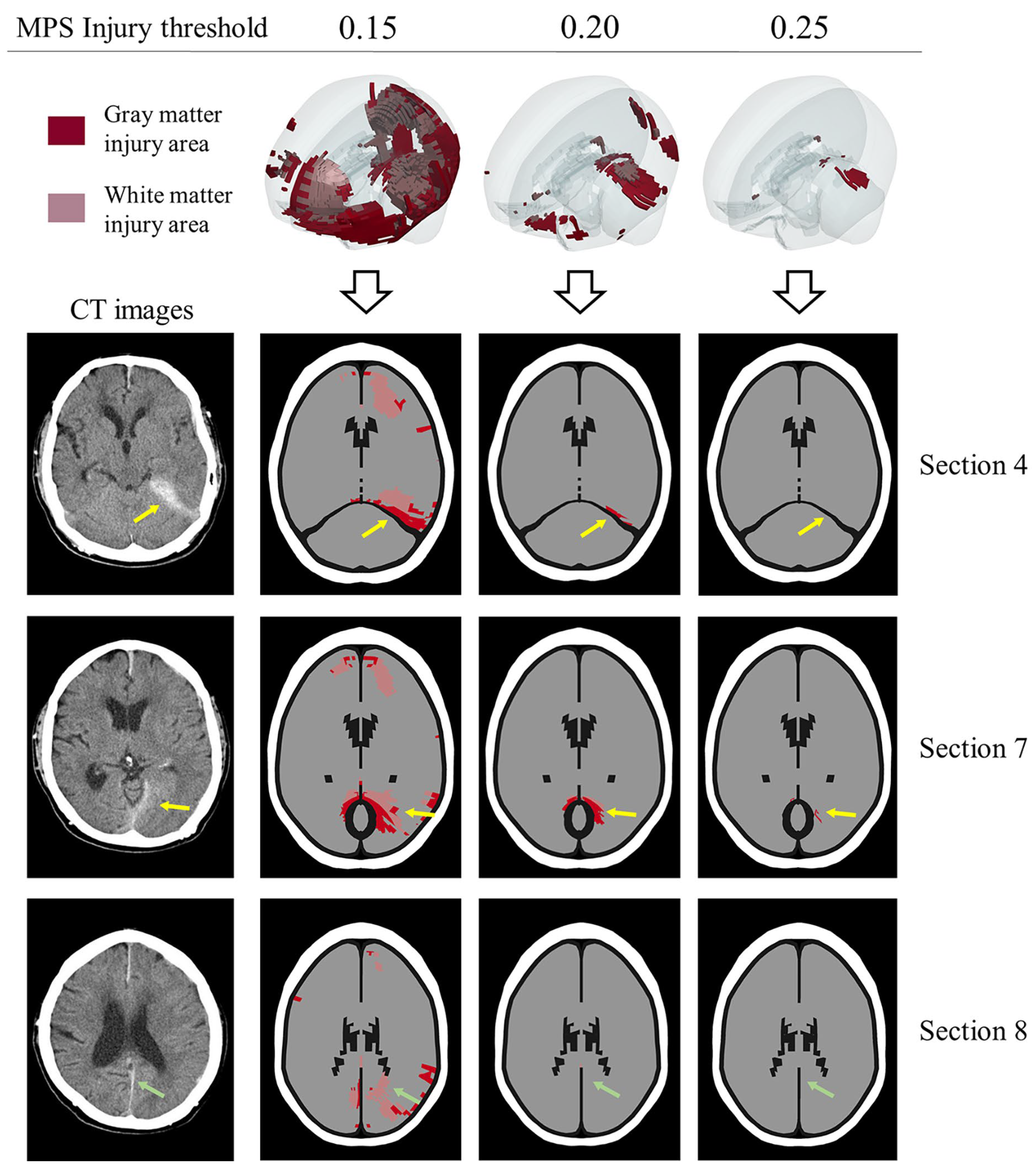
| Case | ||||
|---|---|---|---|---|
| Video analysis | 1 | 3.17 | 0 | 1.72 |
| 2 | 2.37 | 0 | 0.75 | |
| Left occipital impact | - | 0.982 | 0.775 | 2.076 |
| Designed occipital impacts | 1 | 3 | 0 | 0 |
| 2 | 3 | 0 | 1.5 | |
| 3 | 3 | 0 | 2 | |
| 4 | 2.5 | 0 | 1.5 | |
| 5 | 2.5 | 0 | 2 | |
| 6 | 2 | 0 | 1.5 | |
| 7 | 2 | 0 | 2 |
| Injury | Region | MPS Threshold | Reference |
|---|---|---|---|
| 50% Concussion | Corpus callosum | 0.21 | [25] |
| Gray matter | 0.26 | ||
| Corpus callosum | 0.2 | [16] | |
| Corpus callosum | 0.15 | [58] | |
| Thalamus | 0.13 | ||
| White matter | 0.26 | ||
| The entire brain | 0.24 | [26] | |
| The entire brain | 0.27 | [59] | |
| Functional impairment | The entire brain | 0.2 | This study |
Disclaimer/Publisher’s Note: The statements, opinions and data contained in all publications are solely those of the individual author(s) and contributor(s) and not of MDPI and/or the editor(s). MDPI and/or the editor(s) disclaim responsibility for any injury to people or property resulting from any ideas, methods, instructions or products referred to in the content. |
© 2024 by the authors. Licensee MDPI, Basel, Switzerland. This article is an open access article distributed under the terms and conditions of the Creative Commons Attribution (CC BY) license (https://creativecommons.org/licenses/by/4.0/).
Share and Cite
Zhang, Y.; Tang, L.; Liu, Y.; Yang, B.; Jiang, Z.; Liu, Z.; Zhou, L. An Objective Injury Threshold for the Maximum Principal Strain Criterion for Brain Tissue in the Finite Element Head Model and Its Application. Bioengineering 2024, 11, 918. https://doi.org/10.3390/bioengineering11090918
Zhang Y, Tang L, Liu Y, Yang B, Jiang Z, Liu Z, Zhou L. An Objective Injury Threshold for the Maximum Principal Strain Criterion for Brain Tissue in the Finite Element Head Model and Its Application. Bioengineering. 2024; 11(9):918. https://doi.org/10.3390/bioengineering11090918
Chicago/Turabian StyleZhang, Yuting, Liqun Tang, Yiping Liu, Bao Yang, Zhenyu Jiang, Zejia Liu, and Licheng Zhou. 2024. "An Objective Injury Threshold for the Maximum Principal Strain Criterion for Brain Tissue in the Finite Element Head Model and Its Application" Bioengineering 11, no. 9: 918. https://doi.org/10.3390/bioengineering11090918
APA StyleZhang, Y., Tang, L., Liu, Y., Yang, B., Jiang, Z., Liu, Z., & Zhou, L. (2024). An Objective Injury Threshold for the Maximum Principal Strain Criterion for Brain Tissue in the Finite Element Head Model and Its Application. Bioengineering, 11(9), 918. https://doi.org/10.3390/bioengineering11090918







